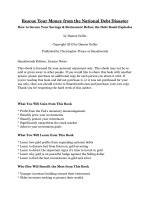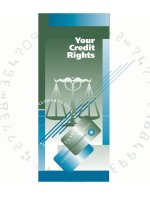Prepare your money plan_1 pot
Bạn đang xem bản rút gọn của tài liệu. Xem và tải ngay bản đầy đủ của tài liệu tại đây (334.82 KB, 21 trang )
ptg
This page intentionally left blank
From the Library of Wow! eBook
ptg
Chapter 2 First Things First . . . . . . . . . .27
Chapter 3 Get FIT (Food, Insurance,
Telecommunications) . . . . . .63
Chapter 4 How to Buy Stuff . . . . . . . .105
Chapter 5 Green Means Green . . . . . .145
25
PART I
Spending Smart Today
From the Library of Wow! eBook
ptg
This page intentionally left blank
From the Library of Wow! eBook
ptg
Y
ou can take a number of supereasy steps to get
your financial life in order. For some tasks, it’s a
matter of actually doing them and crossing them
off your list. Others require periodic maintenance.
Often, these fundamentals alone will put you on a
path to money success. It’s like learning to golf. If you
don’t have a proper grip and stance, your swing is
doomed. Children can’t read until they know the alpha-
bet and what sounds letters make. You’ll be an unsuc-
cessful driver until you learn about the accelerator, the
brake, and the rules of the road.
These fundamentals are always taught—and
learned—the same way, step-by-step, in a process as
easy as 1-2-3.
Taking Stock
Nobody is starting this minute with a clean financial
slate. We already have a lot going on. We’re spending
and saving every day. So, it’s time to take stock.
27
Chapter 2
First Things First
Getting Started
From the Library of Wow! eBook
ptg
Imagine your money life is moving along a timeline.
All you own and all you owe is constantly changing,
with every swipe of your debit card and every deposit in
your retirement plan.
It’s important occasionally to take a snapshot of
where you are now, a freeze-frame in the motion picture
that is your money life.
In the introduction, I wrote about how receiving
financial advice is like taking driving directions from a
GPS navigation device in your car. No matter how good
the machine is, it can’t give you directions to where
you’re going until it knows where you are now. It pin-
points your location by searching for and locking in
satellites as it boots up.
Well, it’s time to boot up with your finances and find
out where you are. It’s the first step in getting to where
you want to go.
28
The 1-2-3 Money Plan
Taking Stock, 1-2-3
1. Take a snapshot. Find out where you stand
now.
2. Look back. Track previous spending to see
where your money goes.
3. Look ahead. Set specific goals for where
money will go in the future.
From the Library of Wow! eBook
ptg
1. Take a Snapshot
There are two simple exercises to hone in on where you
are.
First, add up all the money you ever earned in your
life. I first saw this task in the book Your Money or
Your Life by Joe Dominguez and Vicki Robin. The
book is great, but the authors go into excruciating detail
with this exercise. I think you can get close with just a
little effort.
If you have worked for employers your whole career,
you can total your lifetime earnings fairly accurately
from your annual Social Security statement, which
details how much you earned each year. The statement
comes a few months before your birthday. If you need a
copy, go online to www.socialsecurity.gov/statement to
have one mailed to you, or call 1-800-772-1213.
Also, refer to federal income-tax returns. If you’ve
worked at the same employer for a long time, the
human resources department probably has a record of
your earnings. Estimate other income, such as gifts of
money, family loans that were forgiven, money earned
as a teenager, even significant gambling winnings.
This trip through your earnings history should be
illuminating. It lets you know you have earned signifi-
cant money over your lifetime. This counters any notion
that you don’t have enough money to save or enough
money to manage.
The second step is to figure out what you’re worth
today, specifically your net worth. If you liquidated
everything in your life—sold everything and paid off all
your debts—what would you have to show for it?
29
First Things First
From the Library of Wow! eBook
ptg
Create two columns on paper: all you own (assets) and
all you owe (liabilities).
For example, money in your retirement plan is an
asset. Furniture and jewelry are assets. Don’t stress
yourself out trying to get superaccurate values. Just give
items ballpark estimates. Meanwhile, credit card debt is
a liability, as are student loans and family loans.
If you’re making installment payments on something
you own, it might be both an asset and a liability. For
example, if you own a home with a market value of
$300,000, that goes in the assets column. If your mort-
gage is $225,000, that goes in the liability column. The
result? A net $75,000 is added to your net worth. It’s
similar if you’re making car payments, although some
people actually owe more than the vehicle is worth. If
so, the vehicle actually subtracts from total net worth.
So, now you have two numbers: your total lifetime
earnings and your net worth.
The big question to ask yourself is, “With all the
working and earning I’ve done over the years, what do
I have to show for it?” A lot, or too little?
Of course, much of that earned money went to
necessities that added little or nothing directly to your
net worth—food, clothing, vacations. Meanwhile, some
of your assets have appreciated, such as your retirement
plan or the value of your house.
If you’re still in your working years and your net
worth roughly equals your lifetime earnings, you’re
doing really well. Even if your net worth is a quarter to
a half of your lifetime earnings, you’re not in bad shape.
30
The 1-2-3 Money Plan
From the Library of Wow! eBook
ptg
The ratio should improve to one-to-one or better as you
approach retirement, says Liz Pulliam Weston in Easy
Money: How to Simplify Your Finances and Get What
You Want Out of Life.
But if your net worth is zero or negative, you might
honestly ask and answer, “With all I’ve earned, what do
I have to show for it? Nothing.”
The big question is, “Now that you have a snapshot
of where you are with money, what will you do from
here?” Will you do things to add to your net worth,
such as save and invest? Or, will you buy more con-
sumer goods and services, which subtracts from your
net worth? After 10 more years of earning money, will
you have more to show for it than during the past 10?
A wealth formula from the best-selling book The
Millionaire Next Door provides an interesting exercise.
It offers a measuring stick for how well you are accumu-
lating wealth.
Net worth = your age times your income, divided by 10.
A 40-year-old with a household income of $60,000
should have a net worth of $240,000. And that’s just to
be what the authors called an “average accumulator of
wealth,” AAW. To be what the authors called a PAW,
prodigious accumulator of wealth, you’ll need twice
that much net worth.
A basic philosophy is one often attributed to
American philosopher Bill Earle: “If your outgo exceeds
your income, then your upkeep will be your downfall.”
31
First Things First
From the Library of Wow! eBook
ptg
2. Look Back
Now that you’ve explored your earnings compared with
your wealth, let’s turn to spending. Minding your
spending isn’t a substitute for trying to raise your
income. You still need to do that. But, as I highlighted
previously, spending is where you have the most control
right away.
The best way to get a handle on spending is to track
it. I’m not talking about doing a full-fledged budget.
Instead, just track your expenses and categorize them.
Start by tracking expenses for two months. It does-
n’t matter how you do it. You can use pencil and paper,
a spreadsheet, or software programs such as Quicken or
Microsoft Money. You can keep a notepad with you at
all times to jot down spending, or compile store receipts
with monthly bills less often. If you mostly use debit
and credit cards instead of cash, a convenient list of
transactions will be on your statements.
Then categorize the expenses. Use categories that fit
your spending. Attempt to get a little detail on big
expenditures, such as food. Split it into two subcate-
gories, groceries and dining out.
32
The 1-2-3 Money Plan
QUICK TIP
Several Web sites now offer to help you track spending.
Among the most popular is Mint.com, which is free
and worth considering. It can automatically import
transactions from many bank accounts, credit card, and
investment accounts. It also suggests vendors that could
save you money. Similar sites are Wesabe.com,
Yodlee.com, Buxfer.com, and Geezeo.com.
From the Library of Wow! eBook
ptg
With these categorized totals in hand, this is where
you face the ugly reality that you spend $534 a month
on dining out or that, on average, you spend $156 a
month on shoes. You’re probably already familiar with
your once-a-month expenses, such as your electric bill
and car payment. The more shocking figures will be the
little money leaks that add up. “Do I really spend $50 a
month on bottled water, $40 a month in bank fees, and
$60 a month on DVD movies?”
The point is to identify where your money has been
misspent in the past so you can redirect it toward your
priorities in the future. How do you know if it’s been
misspent? That’s the beauty. You decide.
3. Look Ahead
“Speaking of priorities, how do I get myself a set of
those?”
You set spending goals.
As the saying goes, “If you aim at nothing, you will
hit it every time.” Abraham Lincoln said, “A goal prop-
erly set is halfway reached.” And Benjamin E. Mays, a
mentor to Martin Luther King Jr., said, “It must be
borne in mind that the tragedy of life does not lie in not
reaching your goal. The tragedy of life lies in having no
goal to reach.”
“Yeah, yeah, yeah,” you might be thinking. “Set
goals. Next chapter, please!”
Before you dismiss the importance of setting goals
about money, read on.
Goals give you direction and can provide peace of
mind. They even have application in daily life. With all
33
First Things First
From the Library of Wow! eBook
ptg
the marketing bombarding us every day and fueling our
wants, a set of goals help us to say no. They remind us
there’s something we want more than the tempting pur-
chase right in front of us.
So, the antidote for leaky, undisciplined spending is
having goals.
Developing spending goals is not difficult.
Brainstorm the big, expensive stuff you want to buy and
do. Write them down, both long-term goals and short-
term ones. The only rules are that each objective must
have two components, a dollar figure and a date for
completion. We’ll talk about some of these in-depth
during future chapters, but the following are some typ-
ical goals:
• Eliminate consumer debt. Everybody knows you
want to get rid of debt so you can stop paying
interest. But some of the most valuable benefits
are nonfinancial—less money stress, a sense of
freedom, and possibly more relationship harmony
with your significant other. High-interest credit
card debt should be an urgent priority. Mortgage
debt and low-interest student loans are a lower
priority to pay off quickly.
• Build an emergency fund. Creating a rainy-day
fund can be a two-step process. The long-term
goal is a fund equal to three to six months worth
of bare-bones living expenses, such as food, shel-
ter, and utilities. A shorter-term goal might be to
stash away $1,000 or $2,500. Then, it’s not a cri-
sis or a time to incur debt when the car needs new
tires at the same time the roof needs repairs.
34
The 1-2-3 Money Plan
From the Library of Wow! eBook
ptg
• Buy a house. Be clear about what price you will
pay for a house, which lets you estimate an
amount for a down payment. If you’re already a
homeowner, perhaps you desire a vacation home.
If so, it is unlikely to become a reality unless you
begin planning for it.
• Take a vacation. Vacations are optional, but don’t
totally dismiss the value of shared experiences
with family and friends. Paid-for vacations are
better. I recall a Parade magazine cartoon that
showed a couple sitting on lounge chairs aboard a
cruise ship. Suntan lotion and an umbrella drink
rested beside them. The guy turns to his wife and
says, “This would be a lot more relaxing if we
could afford it.”
• Complete home fix-ups. For homeowners, list
your major home-improvement projects and
home-furnishing purchases in priority order.
• Buy a vehicle. You will replace your car or truck.
It’s just a matter of when. Start talking about the
type of vehicle you might get next and when. That
should give you ample time to start saving a sub-
stantial down payment, or better yet, to pay in
cash. A slightly used car is a better value than buy-
ing new.
• Retire. Past generations often had defined pen-
sions, the kind where they guarantee you a check
every month regardless of what the financial mar-
kets are doing. But, today, it’s your job to figure
out how to squirrel away hundreds of thousands,
and maybe millions, of dollars, before you quit
work. What type of retirement do you foresee?
And when do you expect to gear down your
35
First Things First
From the Library of Wow! eBook
ptg
working life? Where will you be living in retire-
ment? Do you anticipate knocking off work at age
70 and being a homebody or quitting at age 55
and traveling the world? Those plans require
vastly different amounts of retirement savings.
Run through scenarios with easy-to-use calcula-
tors online at such sites as Dinkytown.com or
ChooseToSave.org. Estimate the nest egg you’ll
need. From that, you can back into a single dollar
figure: the amount you should be saving each
month for the type of retirement you want.
• Kids’ college. Although important, saving for
kids’ college expenses is a lower priority than
most. You can often get a low-interest loan for
college expenses, but nobody lends money for
retirement, for example. Open a 529 savings plan
and start contributing regularly, even if it’s only
$50 a month. As you free up money in your life,
revisit this goal and raise your contributions. Few
families will be able to fund all their other savings
goals and save 100 percent of college tuition. Do
what you can. Learn more about college savings
plans online at Savingforcollege.com.
Establishing goals is only the start. The rest is fol-
low-through. Allocate regular and automatic savings
amounts toward each goal that needs to be started now.
We’ll talk more about that in the chapters ahead.
If the goal amounts seem intimidating, break it down
further. For example, don’t think of saving $2,500 for
an emergency fund. Instead, you’re saving $6.85 per
day for a year. Opening separate fee-free savings
accounts for some top goals, such as a car fund, can
36
The 1-2-3 Money Plan
From the Library of Wow! eBook
ptg
help improve your focus on the goal. Set up an auto-
matic draft from your checking account to fund each
goal. Your money is finite, so you might have to delay
funding lower-priority goals until ones that are more
important—or more immediate—are either under way
or completed.
You should also keep close track of your progress
toward achieving the goals, regularly revising both the
dollar figures—upward, we hope—and time frames—
sooner, we hope.
Then, next time you’re tempted with an impulse pur-
chase, you’ll have a reason to say no. That’s fundamen-
tal to spending smart.
Estate Planning
Nobody wants to consider their own demise, but death
planning is part of being an adult.
37
First Things First
Estate Planning, 1-2-3
Make an appointment with an estate-planning
attorney to draw up or update the following
documents:
1. Will.
2. Durable power of attorney for finances and
for health care.
3. Living will (pull-the-plug papers).
From the Library of Wow! eBook
ptg
“Isn’t this a book about saving money?” you might
be thinking. “Why is he telling me to pay an attorney to
draw up these documents?”
You could use lower-cost alternatives, certainly. You
can try to write a will yourself with the help of books.
You can write it with the help of a computer software
program. In fact, a program called Quicken WillMaker
Plus by Nolo generally gets rave reviews. You could buy
the Will & Trust Kit sold by personal finance guru Suze
Orman or use such Web sites as itsmylife.com and
LegalZoom.com.
But sometimes it just makes sense to cough up the
money and make sure it’s done right. This is one of
those times. Consider the issues: Who gets your money
if you die, who gets your kids if you die, who’s going to
pay the bills if you’re physically unable, and should doc-
tors keep you on artificial life support?
Rules vary by state on this stuff. For example, do
you know how many witnesses to the signing of a will
your state requires? If your life is the least bit compli-
cated—for example, estranged family members,
blended families, a special-needs child—these docu-
ments become all the more important. A good attorney
will walk you through all the scenarios, including many
you might not have thought about.
In short, spending a few hundred dollars for an
estate-planning attorney to create these documents is
spending smart. There’s no magic way of choosing an
attorney. Your state bar association will certainly have
a list. But you might ask for recommendations from
friends, relatives, and other professionals you use, such
as an accountant.
38
The 1-2-3 Money Plan
From the Library of Wow! eBook
ptg
1. Will
A will is often the centerpiece of estate planning. Wills
aren’t only for rich people. A will dictates who gets your
money and property if you die. It dictates who will care
for your minor children. If you die without a will, the
state decides.
If you’re married, you might think it’s simple:
Everything—the house, money, and kids—goes to your
spouse. But what if you both die at the same time?
Think car crash. It’s not so clear-cut.
If you’re paying by the hour with an attorney, you
can save money by talking through some scenarios and
making decisions before you enter the law firm’s offices.
If you have children, you need to pick a guardian. You’ll
need to decide on an executor of the estate, which is the
person who manages the assets right after you die. List
your assets and liabilities and decide which beneficiary
gets which asset.
If you already have a will created years ago, whether
by an attorney, software program, or some other way, it
might be worth having an attorney review it again,
especially if your life circumstances have changed signif-
icantly since the will was drafted.
39
First Things First
QUICK TIP
This estate-planning move is absolutely free. Make
sure all your financial accounts have up-to-date pri-
mary and secondary beneficiaries. These accounts
include retirement plans, bank accounts, and life
insurance policies.
From the Library of Wow! eBook
ptg
2. Durable Power of Attorney for
Finances and for Health Care
If you’re incapacitated, you’ll need someone to make
decisions about your money and your medical treat-
ment. These are really different issues and can be differ-
ent people, but you should proactively decide who it
should be in both cases. These documents are generally
part of a package of estate-planning documents an
attorney will draw up for you.
3. Living Will
A living will addresses the scenario that, for some, might
be worse than death. You’re being kept alive artificially,
being fed through tubes and your quality of life has
diminished to near nothing. What type of end-of-life care
do you want if you’re terminally ill or incapacitated?
40
The 1-2-3 Money Plan
Do You Need a Living Trust?
There’s nothing wrong with a revocable living
trust, which is often touted as an alternative or
supplement to a will. This legal document
allows you to transfer assets into a trust while
you’re living, which can help bypass the court
process called probate after you die. It might
save money on legal and court fees during pro-
bate—which is expensive in some states, such as
California—and make the process quicker and
more private.
From the Library of Wow! eBook
ptg
Identity Theft
Identity theft is when someone illegally uses your per-
sonal information, such as a Social Security number or
credit card number, usually for financial gain.
Most important about the advice here is what not to
do. For example, unless you’ve been a victim of identity
theft, you don’t need to pay for credit monitoring.
Monitor your credit yourself by accessing your credit
reports for free, as we’ll talk about in Chapter 6,
“Credit When Credit’s Due.”
Nobody needs to pay for identity theft insurance,
which just reimburses you for incidental costs of clean-
ing up identity theft. It might reimburse you for the
41
First Things First
But living trusts are oversold and cost much
more to prepare than a will. A lawyer-prepared
will might cost $300, whereas a living trust
might cost $3,000, although you can prepare a
trust yourself. Trusts also require more mainte-
nance than a will. For example, you have to
transfer everything you own—personal property
you have now and will buy in the future—into
the trust. That can be a lot of paperwork, both
when setting up the trust and going forward.
If you’re considering a trust, have a good reason
to get one. What is the cost now, and what are
your heirs likely to save later, when you die? And
again, if you want a trust, consider having it
drawn up by an attorney, instead of a salesper-
son selling boilerplate trusts.
From the Library of Wow! eBook
ptg
costs of mailings and phone calls, and perhaps lost
wages and attorney fees. But few victims of identity
theft actually incur any out-of-pocket expenses.
Instead, focus on these three, simple steps to help
prevent identity theft.
42
The 1-2-3 Money Plan
Identity Theft, 1-2-3
1. Be guarded. Think twice about divulging per-
sonal information.
2. Buy a crosscut shredder. Shred mail and doc-
uments containing personal information.
3. Opt out. Stop credit card solicitations by
going online to OptOutPrescreen.com.
These three steps are easy and relatively inexpensive,
especially compared to some of the pricey identity-theft
products and services out there.
1. Be Guarded
This might seem like obvious advice, but it’s by far the
most important. The most dangerous type of identity
theft is when a thief opens a new credit account in your
name. When this happens, it’s often because a thief has
your Social Security number. So, don’t give out your
number unless there’s a good reason. For example, it
seems every doctor’s office wants you to fill out a bunch
of paperwork, which often includes your Social Security
number—it seems, as a matter of routine. I usually just
From the Library of Wow! eBook
ptg
leave it blank or provide the last four digits of my num-
ber. I’ve never had a problem. If you try that and the
doctor’s office insists on getting the full number, at least
get a good explanation as to why.
Less obvious might be safeguarding your informa-
tion by using fewer personal checks. Think about it. A
check has your name, address, and bank routing num-
ber. That’s everything a thief would need to empty your
account. Instead, pay by credit card and electronic pay-
ments. And if you must write a check that you will mail,
avoid putting it in your mailbox for pickup. A thief
might pluck it out of your box before the postal worker
does.
2. Buy a Crosscut Shredder
You should be able to find a good shredder for less than
$50. The finer the confetti it makes, the better. Avoid
ribbon shredders that cut into long strips. Those pieces
can be reassembled by a thief.
Regularly shred all credit card offers, so a thief does-
n’t pick an application out of your trash and steal your
identity. Shred documents that list both your name and
account number, especially your Social Security number.
3. Opt Out
Stop many unsolicited credit offers by visiting
www.OptOutPrescreen.com or calling 1-888-5-
OPTOUT. This will help prevent a thief from stealing a
credit card application from your mailbox and signing up
for a card. You can opt out for five years online or per-
manently by mail using a form available at the Web site.
43
First Things First
From the Library of Wow! eBook
ptg
While you’re at it, opt out of junk mail at www.dma-
choice.org. You must renew after five years. And stop
unwanted catalogs at www.catalogchoice.org. You’ll
reduce paper waste and save a few trees, while reducing
unnecessary spending temptations.
And post your telephone number on the National
Do-Not-Call Registry run by the Federal Trade
Commission. Sign up online at www.donotcall.gov or
call 1-888-382-1222.
For more ways to reduce junk mail, see “Fact Sheet
4: Reducing Junk Mail at the Privacy Rights
Clearinghouse,” at www.privacyrights.org.
44
The 1-2-3 Money Plan
What about Fraud Alerts and Credit Freezes?
Many people try to safeguard their credit files
as an identity-theft prevention measure, hoping
to thwart thieves attempting to open new credit
accounts in their name. Two of the main tools
are fraud alerts and credit freezes.
In short, fraud alerts are a waste of time. Credit
freezes are great if you think you might be at risk
for identity theft.
Fraud Alerts
Fraud alerts are red flags in your credit file. They
are notations that suggest a creditor should
double-check the identity of the person apply-
ing for credit.
From the Library of Wow! eBook









